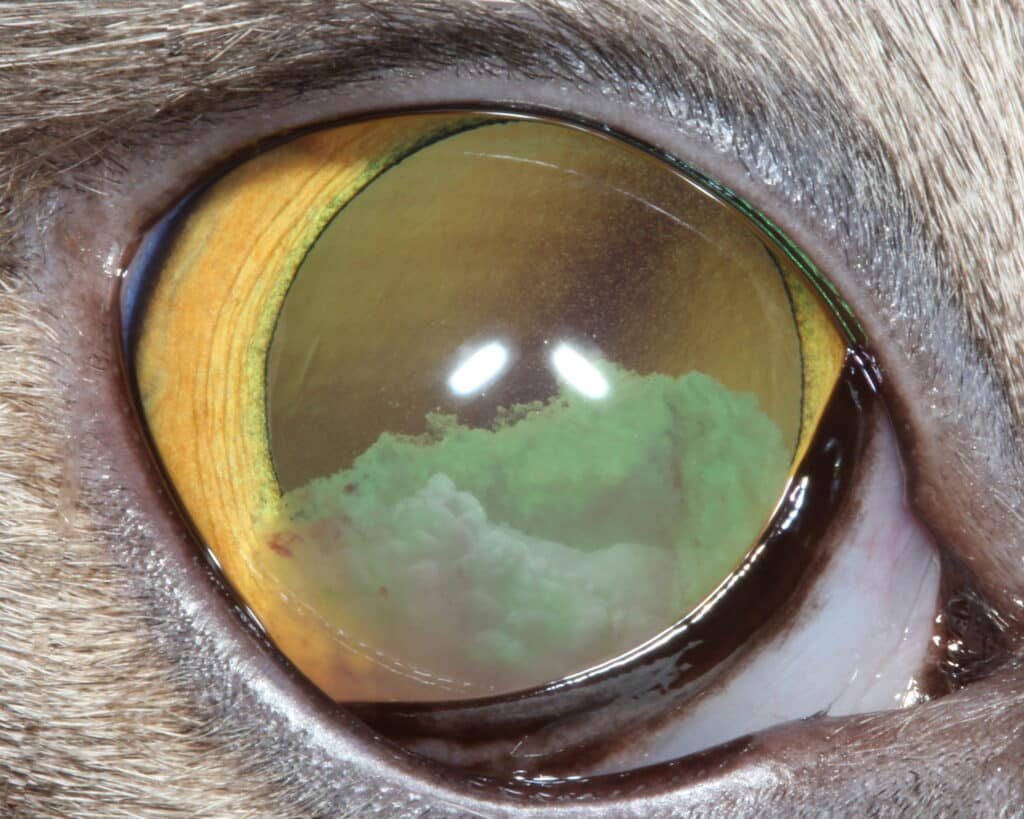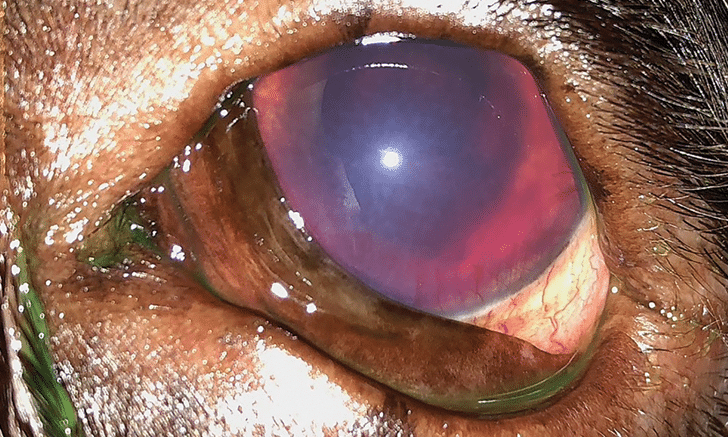- Uveitis in Pets: A Comprehensive View
- What is Uveitis?
- Causes of uveitis
- Uveitis in domestic animals: susceptibility and transmissibility
- Typical symptoms of uveitis
- Diagnostic procedures for uveitis
- Uveitis in Pets: Curability and Management
- Potential complications
- Summary of uveitis in skin animals
Uveitis in Pets: A Comprehensive View
What is Uveitis?
The uvea represents the vascular membrane of the eye and is made up of three main components: the iris (rainbow skin), the ciliary body and the choroid. The primary task of these structures is to ensure the blood vessel supply inside the eye. In medicine, the term “itis” refers to inflammation. , uveitis refers to the inflammation of these internal eye structures.
Causes of uveitis
Direct eye injuries
Sometimes the causes of uveitis can be found directly in the eye:
- Physical trauma such as a blow to the eye.
- Penetrating foreign bodies.
- Eye diseases such as cataracts.
Systemic causes
The inflammation can also be triggered by systemic causes, i.e. those originating from the entire body. This includes:
- Infectious diseases, for example FIP, FIV, FeLV or toxoplasmosis in cats.
- Tumorous diseases.
It is important to emphasize that in some cases, despite intensive investigations, no specific cause can be identified. In such situations, a misdirected immune response is assumed.

Uveitis in a Cat - (C) https://www.msdvetmanual.com/emergency-medicine-and-critical-care/ophthalmic-emergencies/anterior-uveitis-in-small-animals

Uveitis in a Dog (Labrador) - (C) https://www.cliniciansbrief.com/article/hemorrhagic-anterior-uveitis-labrador-retriever
Basic Causes of Uveitis in Pets
Uveitis, the inflammation of the uvea in the eye, can occur in pets for a variety of reasons. It is essential to identify the exact cause of uveitis as this will determine treatment guidelines and prognosis. The following overview lists the basic causes of uveitis in pets.
1. Infectious causes
- Viral Infections: Certain viruses such as FIV and FeLV in cats can cause uveitis.
- Bacterial Infections: Bacteria such as Borrelia, which causes Lyme disease, can also cause uveitis in pets.
- Parasitic Infections: Toxoplasmosis, caused by a parasite, is a known cause of uveitis, particularly in cats.
2. Traumatic causes
- Injuries: Direct trauma, such as a blow or scratch, can cause inflammation in the eye.
- Penetrating wounds: Foreign bodies or bite wounds can also lead to uveitis.
3. Immune-mediated diseases
- Autoimmune diseases: In some animals, the immune system may mistakenly attack the body's own eye tissues, resulting in uveitis.
4. Tumor diseases
- Neoplasm in the eye: Certain tumors or cancers can cause secondary uveitis, either by directly affecting the eye tissue or through secretions that cause inflammation.
5. Metabolic and systemic diseases
- Diabetes mellitus: In some diabetic animals, uveitis may occur as a secondary complication.
- High blood pressure: Increased blood pressure can lead to changes in the eye that promote uveitis.
6. Toxic reactions
- Drug-induced uveitis: Some medications can cause uveitis as a side effect.
7. Idiopathic causes
In many cases, despite comprehensive diagnostics, no clear cause of uveitis can be determined. In such situations, uveitis is called idiopathic.
Autoimmune diseases in pets as a cause of uveitis
Uveitis refers to inflammation of the uvea, the middle section of the eye, and can have various causes in pets. An important category of causes are autoimmunological diseases. In these diseases, the animal's immune system mistakenly attacks the body's own structures, including tissue in the eye. Below are some autoimmune diseases in pets that are associated with uveitis.
1. Systemic lupus erythematosus (SLE)
SLE is a complex autoimmune disease that can affect various organs, including the skin, joints and internal organs. This condition can also cause uveitis in affected pets, especially dogs.
2. Rheumatoid arthritis
Although rheumatoid arthritis primarily affects the joints, systemic inflammatory reactions can also affect other organs, including the eyes. Uveitis is a possible complication in animals with this condition.
3. Polyarthritis
Polyarthritis in animals, especially dogs, can be an immune-mediated reaction that also affects the eye and causes uveitis.
4. Vogt-Koyanagi-Harada syndrome (VKH)
This is a rare autoimmune disease that primarily affects dogs. It is characterized by inflammation of various parts of the eye, including the uvea, and can lead to uveitis.
5. Immunoglobulin A diseases (IgA)
Some dogs may have elevated IgA levels, which can lead to various autoimmune reactions, including uveitis.
6. Pemphigus complex
This is a group of autoimmune diseases that affect the skin. In some animals, the disease can also cause uveitis.
The exact mechanisms of how these autoimmune diseases cause uveitis are not always fully understood. Early diagnosis and intervention are crucial to protect the animal's vision and ensure comfort. veterinarian or veterinary ophthalmologist should be consulted immediately
Uveitis in domestic animals: susceptibility and transmissibility
Uveitis, the inflammation of the eye's internal structures, can occur in a variety of pets. The nature and susceptibility to this disease, as well as the possibility of transmission between different pets, are important aspects to consider.
susceptibility to uveitis
Virtually any pet can develop uveitis. The most common pets affected by uveitis include:
- Dogs: Different breeds may have different susceptibilities. Some breeds are genetically predisposed or have a higher likelihood of developing certain diseases that can cause uveitis as a complication.
- Cats: Similar to dogs, cats can also suffer from uveitis due to certain underlying diseases, such as FIV or FeLV.
- Horses: In horses, uveitis can occur in response to various infections or injuries.
- Small animals: Rodents and rabbits may also be affected, although the incidence may be lower in these animals.
- Birds and reptiles: Uveitis can also occur in these exotic pets, often as a result of infections or other systemic diseases.
Transmissibility of uveitis
Uveitis itself is not a contagious disease. It is an inflammatory reaction and cannot be transferred directly from one animal to another. However, it is important to note that in some cases the underlying causes of uveitis may be infectious in nature.
For example, certain viral, bacterial, or parasitic infections that cause uveitis in one animal can potentially be passed on to another animal. In such cases, it is not the uveitis itself that is transmitted, but the pathogen that causes it.
Interim conclusion
Although uveitis itself is not contagious, it is important to consider the potential transmissibility of the underlying causes. Timely diagnosis and treatment are crucial to avoid complications and ensure the animal's well-being. If an infection or other communicable disease is suspected, pet owners should take appropriate precautions to prevent transmission to other animals.
Typical symptoms of uveitis
Various symptoms can occur with uveitis, including:
- Reddened conjunctiva, often referred to as “red eye”.
- Constriction of the pupil.
- Clouding of the eye.
- Sensation of pain and eye squinting.
- Decreased vision.
Depending on whether the inflammation occurs in the front or back of the eye, these symptoms can vary.
Diagnostic procedures for uveitis
If your pet shows symptoms of uveitis, a comprehensive examination by a veterinarian be carried out. This can include:
- A general examination.
- A complete blood count.
- Specific blood tests for possible infectious diseases.
- Ultrasound of the abdomen.
- Chest X-ray.
- A puncture of the aqueous humor for analysis.
Uveitis in Pets: Curability and Management
If a cause for uveitis is identified, such as an infection, primary treatment will be directed toward that. Regardless of the underlying cause, treatment for uveitis usually includes:
- Eye drops containing cortisone.
- Pupil dilating medications.
- Systemic anti-inflammatory medications.
It is crucial that all medications are administered exactly as directed by the veterinarian.
Detailed treatment options and prognosis
- Infectious uveitis: If uveitis is caused by an infection, such as bacteria, viruses, or parasites, targeted antimicrobial therapy can eliminate the infection and cure the uveitis.
- Traumatic uveitis: Caused by injury or foreign body in the eye. Such cases can be curable if detected early and treated appropriately.
- Uveitis due to autoimmune diseases: For uveitis caused by autoimmune diseases, the main goal of therapy is to control inflammation and not necessarily cure. However, with appropriate immunosuppressive therapy, symptoms can often be well controlled.
- Idiopathic uveitis: In cases where no specific cause is found (idiopathic), the focus is on relieving symptoms and minimizing complications.
- Uveitis due to tumors: For tumors that cause uveitis, the prognosis depends largely on the type of tumor, its location and the extent to which it has spread.
Treatment strategies
Treatment of uveitis can include different approaches:
- Topical therapy: Corticosteroid eye drops to reduce inflammation.
- Systemic medications: Anti-inflammatory medications, immunosuppressants, or specific antimicrobials, depending on the cause.
- Surgical intervention: In some cases, particularly traumatic uveitis or when a tumor is present, surgical intervention may be necessary.
Potential complications
If cases of uveitis persist, there is a risk of increased intraocular pressure, known as secondary glaucoma. This can be treated with medication, but in severe cases it can cause blindness and even loss of the eye.
Sequelae of uveitis in pets and the risk of blindness
Uveitis, an inflammation of the middle layer of the eye, can have various causes in pets and lead to a number of secondary diseases. Some of these diseases can significantly impair vision and even lead to blindness.
1. Cataract (cataract)
- Description: A clouding of the eye's lens, called a cataract, may develop as a result of persistent uveitis.
- Risk of blindness: If the haze is advanced, it may impede light transmission and cause significant visual impairment or blindness.
2. Secondary glaucoma
- Description: Uveitis can lead to increased intraocular pressure, known as secondary glaucoma. This happens due to impaired drainage of the aqueous humor.
- Risk of blindness: An uncontrolled increase in intraocular pressure can damage the optic nerve, eventually leading to blindness.
3. Retinopathy
- Description: The inflammation can spread to the retina and lead to a condition called retinopathy.
- Risk of blindness: Damage to the retina can lead to permanent vision problems or complete blindness.
4. Band keratopathy
- Description: Calcium deposits may form on the corneal surface, especially after chronic uveitis.
- Risk of blindness: These deposits can impair the cornea's ability to transmit light, but they usually do not cause total blindness.
5. Phthisis bulbi
- Description: A shrinking and nonfunctional eye secondary to severe and chronic uveitis.
- Risk of Blindness: This condition results in a blind eye.
Diagram: Common Causes of Uveitis in Pets
The health and well-being of our animals should always come first. If there are any signs of eye problems, including symptoms of uveitis, a veterinarian be sought immediately. With timely diagnosis and treatment, many of the negative consequences can be avoided.
Summary of uveitis in skin animals
Pet uveitis is a serious eye disease characterized by inflammation of the uvea. Uveitis in pets can cause symptoms such as redness, pain, and cloudiness in the eye. The exact cause of uveitis in pets can vary, with both local and systemic factors playing a role. Early diagnosis of uveitis in pets is crucial to avoid complications and potential complications.
Uveitis in pets can cause blindness if left untreated. Treatment of uveitis in pets aims to reduce inflammation and address the cause of the disease. Since uveitis in pets can in some cases be caused by systemic diseases, a comprehensive medical evaluation is necessary. Uveitis in pets can be diagnosed through various tests and imaging techniques.
The prognosis of uveitis in pets depends on the severity and underlying cause of the disease. It is crucial to consult a veterinarian immediately if you suspect uveitis in your pet.
